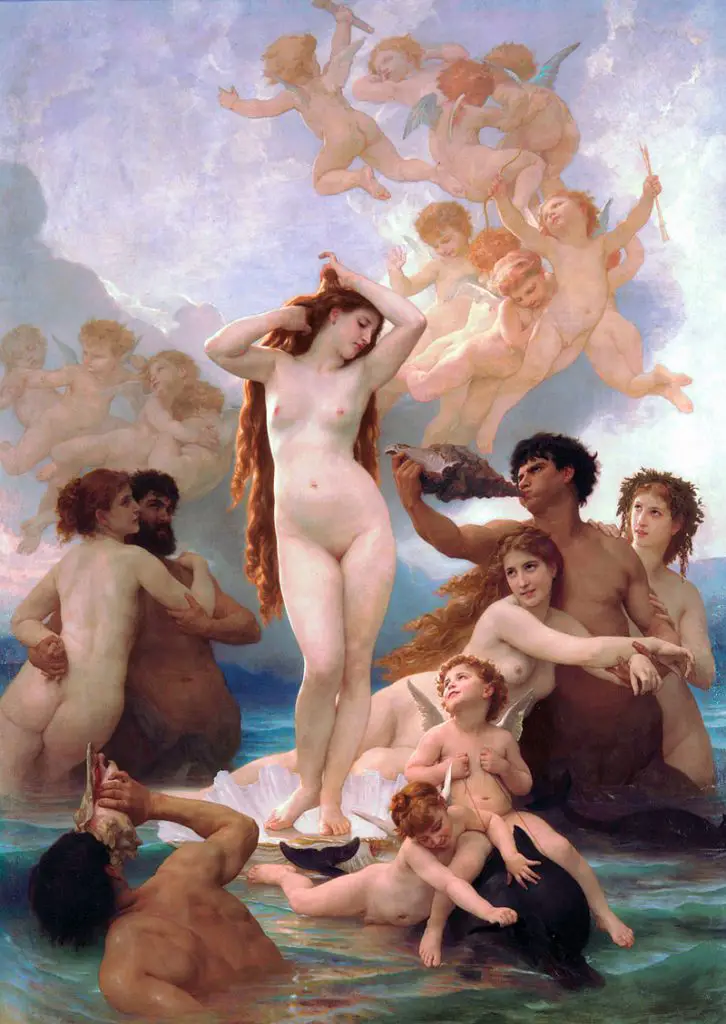The Birth of Venus can be said to be one of the most renowned paintings by William Adolphe Bouguereau. The picture does not depict the actual birth of Venus from the sea, but the transportation of her as a fully mature woman from the sea to Paphos in Cyprus in a shell.
Venus has often been considered as the ideal form and beauty in the Classical Greek and Roman mythology. The canvas is a little more than 9 ft 10 in tall and 7 ft 2 in high.
Both the subject matter and the composition of the painting shows quite a resemblance to the previous rendition of the subject – Raphael’s The Triumph of Galatea and Sandro Botticelli’s The Birth of Venus.
History of The Birth of Venus
The Birth of Venus was painted by William-Adolphe Bouguereau in 1879 and was originally commissioned for the Paris Salon. However, it was later purchased to be housed in the Musee du Luxembourg.
The painting – The Birth of Venus – had also won the prestigious honor of the Grand Prix de Rome. During the 19th century, many of the artists would paint images from history or the biblical times.
They would also cite cultural and intellectual references in the artistic work. Many of the artists also studied the female form and even perfected the art of painting women in their natural and adorned beauty.

Many of the images of these times had become an eclectic mix of images, portraying the female form on canvas in a stylish, sensual and even a seductive manner.
Bouguereau had become a member of the Art Academy in 1876 and was one of the first artists to create such paintings. He was also known to be a devout Catholic, which had a profound impact on the style of his painting and the subject matter.
The Birth of Venus: Description and Analysis
The Birth of Venus by Bouguereau can be said to be one of many paintings that had been born of the same subject – the goddess Venus. He had derived inspiration and passion from Sandro Botticelli’ paintings of Venus to create his own personalized version. When the painting is viewed, it is observed that Venus is standing at the central point of the painting, naked.
The viewer’s eyes would automatically wonder to focus on her nude body, keeping with the fact that she had just been born and had risen from the sea. It can also be seen that she is standing on a floating platform that seems to be encrusted with scallop seashells. It can also be seen that she is being pulled along in the water by a dolphin.
There are also several other mythical and fantastic creatures, surrounding and staring in wonder at the beauty of Venus, including Psyche, nymphs, centaurs, and Cupid. Two of the centaurs in the painting are blowing into shells, announcing the birth of Venus. Everyone else is busy staring at her beauty and welcoming her after her birth.
Birth of Venus by Bouguereau
Venus is beautiful and feminine and had been clearly depicted by Bouguereau n the painting. This had been depicted by the slight tilt of her head, her calm, peaceful, facial expression and relaxed self, being nude before others.
Bouguereau had enhanced the curvaceous lines of her body, thus allowing her to throw the arms in the air and freeing her hair to fall gently around the shoulders. The muse for Bouguereau’s The Birth of Venus was a princess by the name of Marie Georgine.
The artist had met her when she was in Paris with her lover in 1861. The couple had modeled for two of Bouguereau’s earlier paintings – Flora and Zephyr and The Abduction of Psyche.
Characters in The Birth of Venus
He had referred back to the old pictures for working on this one. There can be no argument about the artistic skill in the painting with the characters perfectly in stature, but there is a lack of felling in them, probably owing to the contemporary nature of the painting.
There is little emotion or passion that can be seen emanating from Venus. The painting is one of the most beautiful ones ever created by Bouguereau who was very popular, successful and inspirational at his time.
The painting is permanently housed in the collection of the Musee d’Orsay in Paris at the present.